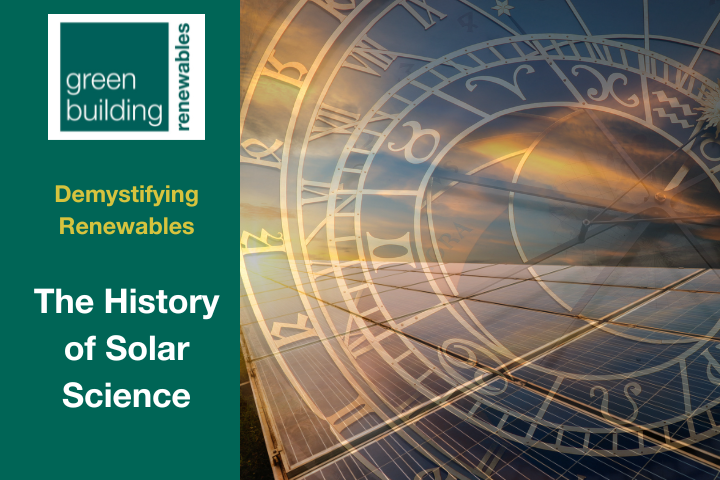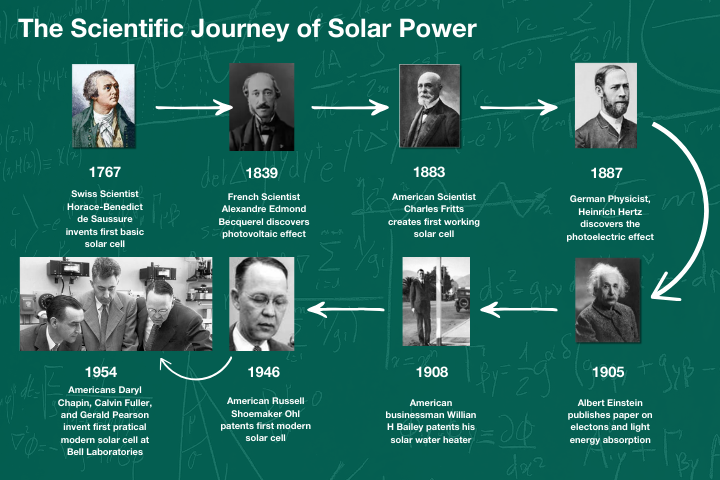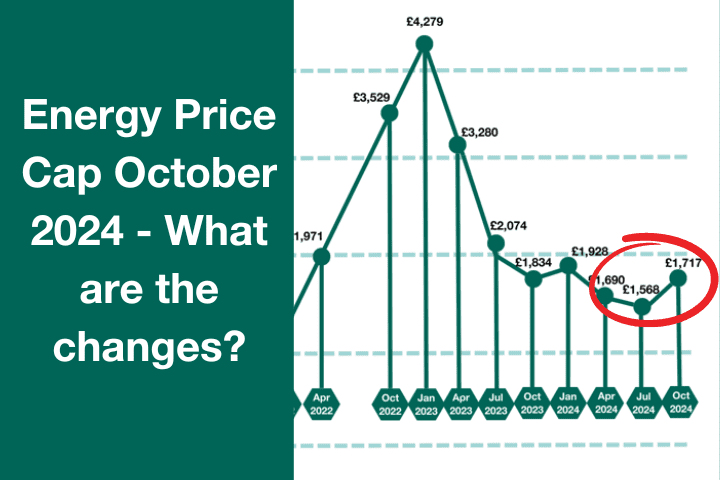8 Interesting Questions Answered about the History of Solar

The History of Solar Technology and its science is over 250 years old. This blog answers eight questions about the history of solar science and introduces some well-known and less well-known scientific names.
In the last few years, we’ve all become more environmentally conscious and understand the need for a secure energy future for the UK.
The external influences that can affect the energy cost to our homes have become more apparent. As both individuals and a society, we are becoming committed to reducing our carbon emissions, transitioning away from fossil fuels, and embracing cleaner alternatives to energy – like solar.
At Green Building Renewables, we think solar energy’s significance for transforming homes and lives cannot be overstated.
The abundant and renewable nature of sunlight, coupled with smart technological advancements, positions solar power as a key contributor to the UK’s energy mix.
Harnessing the sun’s power not only aids in meeting renewable energy targets but also fosters energy independence, drives economic growth, and mitigates the impacts of climate change.
As solar technology continues to evolve, we believe that more and more people will want this life-changing energy in their homes. And as the technology develops, it will only become more accessible to more people.
Solar is an energy solution for the future. But the technology has been around for much longer than you might realise. In this blog, we’ll take a look at the history of solar energy and take a look at a few more facts and figures about solar.
Table of Contents
History of Solar Science Question 1: When was solar energy discovered?
It’s safe to say as long as there have been humans on the planet, we have, in some form, understood the importance of the power and the energy of the Sun.
Worshipped by ancient civilizations as a god, the Sun is ultimately the source of all energy within the food chain, regardless of your diet. We have harnessed its power to grow food and create fire for centuries.
In terms of solar power, cells, and electricity generation, that story begins in the 18th Century, when the fantastically named Swiss Scientist Horace-Benedict de Saussure designed the first solar cell in 1767.
Horace realised that the sun’s power could be magnified and increased by placing three layers of glass in an insulated box with an opening.
After Horace’s discovery, it probably wasn’t long before the destruction that magnifying lenses and the sun could cause on classmates’ books and unsuspecting ants became the wicked entertainment for playground escapes of school children everywhere.
In 1839,19-year-old, basically, still a schoolboy himself, French physicist Alexandre Edmond Becquerel first discovered the photovoltaic effect.
History of Solar Science Question 2: Who was Alexandre Edmond Becquerel, and what solar discovery did he discover?
Alexandre Edmond Becquerel was born in Paris, France, on March 24, 1820, and was part of a distinguished scientific family. His father, Antoine César Becquerel, pioneered the study of electric and magnetic phenomena.
Alexandre Edmond Becquerel is particularly known for his work on the photovoltaic effect, laying the groundwork for solar cell development. He discovered that certain materials produce an electric current when exposed to light. This phenomenon, known as the photovoltaic effect, is the underlying principle behind the functioning of solar cells.
Although Becquerel’s discovery was a crucial step in understanding the relationship between light and electricity, it wasn’t until later, in the mid-20th century, that practical applications of the photovoltaic effect were developed, leading to the creation of the first solar cells capable of generating electricity from sunlight.
History of Solar Science Question 3: Who invented the first solar voltaic cell?
The first solar voltaic cell, be it very inefficient, can be credited to American Scientist Charles Fritts.
Charles Fritts created the first working solar cell in 1883. He coated the semiconductor material selenium with an extremely thin layer of gold, which resulted in cells with a converted electrical efficiency of only about 1%.
The world’s first rooftop solar array, using Fritts’ selenium cells, was installed only a year later, in 1884, on a New York City rooftop. His cells found uses in devices like light sensors for exposure timing in photo cameras, which were common well into the 1960s. The high costs, however, of selenium made them impractical for use in solar energy systems.
Even Einstein got involved in the History of Solar Science
Albert Einstein is arguably the most famous scientist of all and even played a role in the scientific progression of solar energy.
In 1887, German Scientist Heinrich Hertz discovered the photoelectric effect. Building on the work of Hertz, Albert Einstein published a scientific paper in 1905 describing how electrons are released from solids, liquids or gases when they absorb light energy.
Three years after that, in 1908, American Inventor William J Bailey patented his solar water heater, a device that separated into two parts: a heating element exposed to the sun and an insulated storage unit tucked away in the house so a family could have sun heated water day and night. His Copper Collector improved the efficiency of the original collector method further by using copper insulation. The improvements achieved by this method are still being used in modern solar panels today.
History of Solar Science Question 4: How did solar panel technology develop in the 20th Century?
It wasn’t until the mid-20th century that practical applications of solar power, however, really emerged – thanks to another scientist with another great name – Russell Shoemaker Ohl.
History of Solar Science Question 5: Who invented the modern Solar cell or panel?
American Scientist Russell Shoemaker Ohl, born in 1898, is recognised for patenting the modern solar cell. He created the modern junction semiconductor solar cell, which he patented in 1946.
Russell Ohl worked at Bell Laboratories, where the first practical photovoltaic cell was later invented by Daryl Chapin, Calvin Fuller, and Gerald Pearson in 1954. The team of three worked on thin silicon strips, attempting to turn it into a strong conductor of electricity.
The three scientists soon realised that their silicon solar cell could convert sunlight into electricity and was a viable power source. The trio tweaked the technology until it converted 6% of all incoming light into usable electricity. The invention of the silicon solar cell is considered a breakthrough in the history of solar energy, and it made what we do today possible.

History of Solar Science Question 6: How efficient are modern Solar Panels?
In the 1970s, a company called Hoffman Electronics successfully increased the efficiency of solar panels to 14%. Today, modern solar panels have an efficiency of, on average, around 15% – 20 % conversion of sunlight to usable energy. For high-efficiency solar panels it is as high as 23%.
As demand has increased, so too have the advancements in technology. Last year, it was reported that solar cells with 30% could soon make their way to the market.
So, that’s a potted history of solar technology, but what about in the UK, when did solar power first appear in the UK?
History of Solar Science Question 7: What was the first building in the UK to get Solar?
The first building in the United Kingdom to be equipped with solar panels was the “Garden House” at the University of Sussex in 1978. This installation was a pioneering effort that marked an early adoption of solar technology in the UK. The solar panels were primarily used for heating water, showcasing the potential of solar energy for practical applications in buildings.
The first social houses in the United Kingdom to incorporate solar panels were in the Woking borough of Surrey. This landmark project, known as the “Solar Park,” was initiated in 1986 by the energy services company Thameswey.
The Solar Park featured a cluster of 83 homes with solar panels, including private and social housing units. The installation aimed to demonstrate the feasibility of solar energy for residential use, providing both electricity and hot water to the occupants.
The success and lessons learned from early initiatives like the Solar Park have shaped subsequent developments and policies related to solar energy in the UK. As technology has advanced and awareness of the importance of renewable energy has grown, solar panels have become even more common in residential and social housing projects throughout the country.
History of Solar Science Question 8: Where is the first solar farm in the UK to power the grid?
The first solar farm in the UK to feed electricity directly into the transmission network was a 49.9MW solar farm located near Bristol, owned and operated by Cero Generation and Enso Energy. The solar farm was connected to the National Grid’s transmission network in May 2023 and is co-located with a 49.5MW / 99MWh battery energy storage system.
The UK’s largest solar farm, however, is actually in Wales. Commissioned in March 2016, Shotwick Solar Park was collaboratively developed by We-Link Energy and Compton Group. It produces 72.2 MW per year and is spread over 250 acres.
Solar Park is the largest private wire solar park in Europe. It generates and feeds private infrastructure with power, including the UK’s largest paper mill, UPM Shotton Paper Mill. It supplies 70% of the paper mill’s energy requirements and saves the business 22,5000 tonnes of CO2 emissions annually.
Solar Power in the UK Today
In the 21st century, there has been a surge in solar installations in the UK, fueled by technological advancements, growing environmental awareness, and more affordable domestic and commercial solutions. Government incentives and supportive policies have also helped propel the adoption of solar energy in the UK.
According to the latest MCS data, it suggests there are now 1.3 million UK homes with solar panel installations. This equates to 4.1% of the 29 million homes in the UK. Over 1,000 solar farms are now operating in the UK too.
In terms of commercial installations in the UK, it was reported by Trade body Solar Energy UK (SEUK) last year that the UK had set a new annual record for 2023 with 138,336 solar PV installations since 2022, up from 137,926 last year.
From Horace to your home
It is over 250 years since Horace invented the first solar cell. In that time, the science of solar energy has developed, and the technology’s true potential is now being realised for how transformative it can be for our homes.
If you are interested in Solar for your home and want to be part of this 250-year-old scientific evolution from Horace to your home, get in touch today. Who knows? Adding solar power to your home might even help inspire the next generation of brilliant scientific minds. Find your local installer here.




